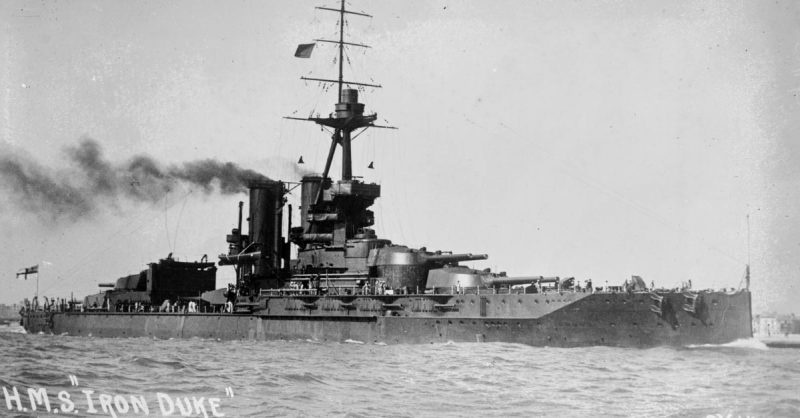Perhaps the Duke of Wellington, were he alive in 1914, would have objected to a second battleship again named after him when the first HMS Iron Duke, scrapped in 1906, had the dubious honor of ramming and sinking HMS Vanguard, another Royal Navy battleship.
The second Iron Duke was the name ship of the last class of dreadnoughts to enter Royal Navy service prior to the start of the First World War. It and its sisters were deemed “super-dreadnoughts,” an imprecise term that separates the second generation of dreadnought battleships from the first.
Generally speaking, super-dreadnoughts did away with wing turrets, and mounting guns in the centerline with super-firing turrets. Virtually all super-dreadnoughts carried weapons heftier than twelve inches (although this differs from country to country), and had more advanced armor structures.
Laid down in 1912, Iron Duke launched in March 1914.
It carried ten 13.5-inch guns in five twin turrets and displaced twenty-five thousand tons.
Its ancillary armament, positioned in single casemates, contained twelve six-inch guns. Like many Royal Navy battleships of the time, it could manage a speed of twenty-one knots.
Iron Duke was a well-designed ship, with superior firepower compared to German (if not its American) counterparts.
The Iron Dukes (following the King George Vs and Orions) were the third four-ship class of super-dreadnought, and marked a stunning increase of peacetime naval construction by the United Kingdom.
The Royal Navy, in competition with Germany, commissioned twenty-two super-dreadnoughts between 1912 and 1917, as well as other half-dozen battlecruisers.
Only U.S. aircraft-carrier construction in World War II can equate with this level of output.
Upon its creation in August 1914, HMS Iron Duke became the flagship of the Grand Fleet. Iron Duke sported the flag of Adm. John Jellicoe, who had been promoted by Winston Churchill to command at the start of the war.
Jellicoe’s responsibility was to not lose the war, and the tactic was to prevent being destroyed by the German High Seas Fleet. Since the German fleet was of fewer numbers than the Grand Fleet and was restricted geographically, this was an achievable mission.
Jellicoe knew that numerical superiority was the key to victory in modern naval warfare, and constantly refused to permit the Royal Navy to meet the High Seas Fleet in detail.
Accordingly, the Grand Fleet occupied most of its time practicing seamanship drills and gunnery, interrupted by the irregular sortie to try to find the High Seas Fleet in the open.
The sole genuinely productive sortie of this type came in late May 1916, when Iron Duke at the Battle of Jutland served as Jellicoe’s flagship. At the front of the British line, it caused serious damage to the German battleship SMS Konig, as well as several minor vessels.
The German ships escaped in the darkness, however, and Iron Duke returned to Scapa Flow as the Navy became bogged down in squabbles.
The failure to eliminate the High Seas Fleet, despite obvious British superiority, took a heavy toll on elite and public opinions of Admiral Jellicoe. Jellicoe was ultimately “promoted” out of the Grand Fleet command structure.
The Washington Naval Treaty reduced the world’s battleship fleets, but Iron Duke survived the first reduction of 1922. It served lengthily in the Mediterranean and the Black Sea, and in helping to manage the repercussions of the Greco-Turkish War and the Russian Civil War.
In the latter part of the 1920s, The Royal Navy examined a modernization scheme, but expected the impending London Naval Treaty of 1930 to further lower the number of allowable battleships.
Instead of modernization, Iron Duke was taken out of service, losing much of its armament and most of its armor. It served as a gunnery training ship for the remainder of the 1930s, and was an accommodation ship at the commencement of World War II.
In October 1939, extended-range German bombers attacked Scapa Flow, and damaged it sufficiently enough to force a grounding.
A March 1940 raid caused additional damage, and Iron Duke would remain at Scapa Flow for the rest of the war. Iron Duke was sent to the breakers in 1948, Scout reported.
HMS Iron Duke and its sisters perfectly captured the “super dreadnought” model; their large guns, tripod masts and balanced gave them a formidable appearance.
Its sort was, for the most part, useless during the war. The Royal Navy made no attempt to restore it for combat in a frontline role, as it would have suffered terribly under the guns of modern Italian, German and Japanese warships.
